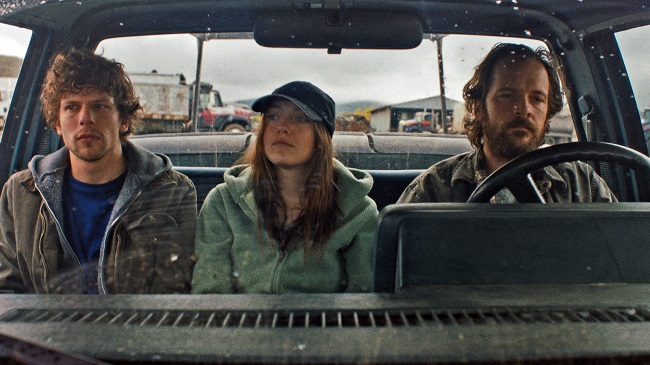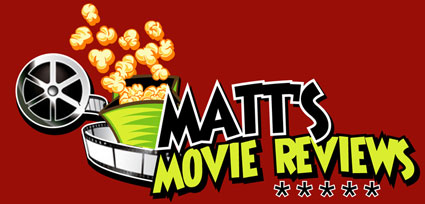Over her almost 20 year career director Kelly Reichardt has steadily become a lauded name in American indie filmmaking. Although making her debut in 1994 with the crime drama River of Grass, it was Reichardt’s last few releases with screenwriter Jon Raymond - Old Joy, Wendy and Lucy, and Meek’s Cutoff - that put her name and distinct slow-burn style on the indie movie map.
Now Reichardt has returned with the nail bitting thriller Night Moves, another collaboration with Raymond that follows three radical environmental activists (Jesse Eisenberg, Dakota Fanning, Peter Sarsgaard) as they plan to blow up an hydroelectric dam.
Matt’s Movie Reviews spoke to Kelly Reichardt about the making of Night Moves, how she approaches her projects and the Oregon area which all of her films are set.
Enjoy!
I read that you had practically walked away from filmmaking after ‘Meek’s Cutoff’. What was it about this story that brought you back?
No….that never happened. Probably after my first film River of Grass which there was a 13 year gap. That was the walk away from filmmaking time (laughs). But after Meek’s Cutoff we were actually…you might have read this, I did think after making Meek’s Cutoff we would never be allowed to make another film.
I thought “This is really it”, because I had this big bonnet where you couldn’t see the actresses faces which really makes this film…as all of these films have been that I wanted to make, but that one felt a little more extreme and I thought “Well, I might as well do it exactly as I want because this will probably be the last film I ever made.”
It always feels like the last film, because this kind of filmmaking, let’s face it, it’s a sinking ship.
When did the origins for Night Moves begin? What was the initial creative spark that spiralled into this story?
It actually came from (screenwriter) Jon Raymond, who had friends that had a farm down in southern Oregon, and he began spending time there with his family and becoming interested in the sort of local politics of the community surrounding the farm, and started bringing me down there to spend time on the farm.
We knew we wanted to make something there. Jon had this idea of this fundamentalist character who would be hiding out in this organic world, and that was sort of the beginning seeds of it.
What I loved about Night Moves is that I really felt the weight of ramifications from these characters actions, yet didn’t feel manipulated into doing so. How important was it to portray the moral dilemma in the story, without resorting to a morality play?
We just really tried to keep our own politics out of the film. We drew backgrounds for all of the characters and really tried to stick to what they would do, and what their actions would be and their motives, and try to keep our own agendas completely out of it and make a character film. That was sort of our rules of the game.
 |
“We drew backgrounds for all of the characters and really tried to stick to what they would do, and what their actions would be and their motives, and try to keep our own agendas completely out of it and make a character film.” - Kelly Reichardt |
You also edit your own movies. Do you make mental notes of how you would want a scene edited while filming, or do you save that energy for post-production?
I’m always sort of thinking about the cut when storyboarding and thinking about the shots. Having said that, I’m a big, big planner but then I shoot in this atmosphere of…I shoot in a state of crazy weather, and where I don’t have rehearsal time.
So I do a lot of planning and setting out with the location with my view finder by myself, and then eventually with my (Director of Photography) Christopher Blauvelt so that then I’m not really gonna know what the shot’s like. I can’t…like in Meek’s Cutoff I don’t have the bull until the day that Michelle is driving the bull across the plain. I’m not gonna really know what that’s like until that’s happening.
So it’s this kind of complicated combination of extreme planning and then shooting the film like you’re on fire, because there is never enough time and there’s not enough resources, and just trying to stay flexible in the key moments as it turns out to be.
A lot of people – including myself – view Night Moves as a thriller. Do you ever approach your projects in terms of genre? Or is it - as you said before - about letting your characters and their story take the film to whatever direction they want?
With (Night Moves) I was into putting this story that Jon was thinking of into a thriller kind of frame. So we worked with that from the early days of the script, and tried to take a well-known frame and put something in it.
It was sort of more ambiguous and more different with less of the good guys, bad guys kind of genre trappings, but still using the framework of the genre.
In regards to that type of filmmaking, did you have any direct influences with how you wanted to approach this story?
Well you know I teach film, so I’m forever deconstructing films and I’m sure there is plenty under my skin. I did at a point show when we were writing…I showed Jon the break in scene in Rififi of just like, I want to get down to the play by play of this bomb in this way like…the story stops because this thing has to happen, in just getting down to the real minutia of it.
But, you know I look at films all the time. You look at a lot of stuff and read a lot of stuff. Robert Adams photographs always seem to play into things and in this case Charles Burchfield’s paintings were an influence. You know, we both went back and read “Crime and Punishment”, and there is the topics of radicalism that came out in the ‘70s of Fassbinder and Godard and other films that dealt with those topics. A lot of fun research, actually.
You worked with three great actors in Jesse Eisenberg, Dakota Fanning and Peter Sarsgaard. Three great performances from all of them…When developing your projects do you ever have actors in mind for your roles?
Yeah I have before and sometimes it works out that you end up with those actors. Sometimes it doesn’t. I mean, casting is such a long…I mean, with Meek’s Cutoff we wrote Michelle’s role for Michelle and the Will Patton role for Will Patton. But casting is such a long and…there’s a lot of arbitrary things that happen, and you know I’m super lucky to get the actors.
I’ve worked with so many great actors. But it doesn’t always end up that you’re shooting the film with the actor you first imagined. You know there’s scheduling, and raising money, and all the various things that come into play that no one ever talks about when they talk about how a movie gets cast (laughs).
 |
"I had more time with Jesse (Eisenberg) then I usually have with actors. He and Jon Raymond and I spent the time together, and we went to some activist meetings together, and he lived up in the area for a while. With him we worked on a couple of scenes, because he is big into rehearsing and he and I had that time together." - Kelly Reichardt |
When you get your actors on set how do you like to approach working with them? Do you have a strict structure considering the time constraints in filming? Or do you like them to add a little more in terms of improvisation to the script?
No…not big on improving. We don’t have a lot of time and I really like to stick to the writing.
Though there have been times…two times I can think of…you know (actor) Will Oldham, his story in the end of Old Joy, I knew I didn’t want to use the same story that was in Jon Raymond’s short story.
I wanted it to be different and I didn’t know exactly what it would be, and then the story that Will end’s up telling is partially something that happened to him on an off day of shooting when he was in Portland, and it got incorporated into some of the elements in the original story. I didn’t really hear the entirety of how he was going to put the story together until we were filming, because that is just how he wanted it to be. He wanted to just tell me a story.
And in Night Moves there were a couple of scenes that Jesse (Eisenberg) wanted to change the tone of, and he came early and he lived on the farm, so I had more time with Jesse then I usually have with actors. He and Jon Raymond and I spent the time together, and we went to some activist meetings together, and he lived up in the area for a while. With him we worked on a couple of scenes, because he is big into rehearsing and he and I had that time together.
So that was unusual, but it wasn’t improvised on the spot. It was worked into the script. But we tried different things, he and I together going over the script before we shot. Mostly things are going really fast so it doesn’t always go that way.
Night Moves – like other movies in your filmography – is set in the Oregon area. What is it about that part of America that you are drawn too?
Well in the most practical sense I did the last four films with a writer who is born and raised in Oregon. You know I first started going out there when my friend Todd Haynes moved out there, and I’m from Miami a place where it’s white concrete and flat one story buildings, so of course to go out into the pacific northwest it was quite a shocking, different environment and one I really enjoyed filming.
And just because I spend so much time scouting I have come too really, really know that state, and it’s a super diverse state. It has a desert, and an ocean, and a rain forest, and now a lot of my crew lives there. I am attached to it and sort of split my time there, so just the practical-ness of the budgets we work on, it helps that we sort of know how to make films there, and are kind of set up in away.
So it’s all those things, but a lot of it is from having worked with Jon Raymond, the writer I’ve been working with on the last four films.
|
